For scientific focus stacking, apochromatic lenses offer superior resolution and color accuracy compared to achromatic alternatives. Consider microscope objectives with plan-apochromatic designs for flat-field imaging and minimal aberration. For macro work, lenses with longer focal lengths provide better working distance while maintaining detail. Software like Helicon Focus integrates seamlessly with quality lenses for ideal results. Budget options include the Laowa 60mm f/2.8 2:1 Ultra Macro. The following sections reveal specialized configurations for different scientific applications.
Understanding Focus Stacking Technology for Scientific Imaging
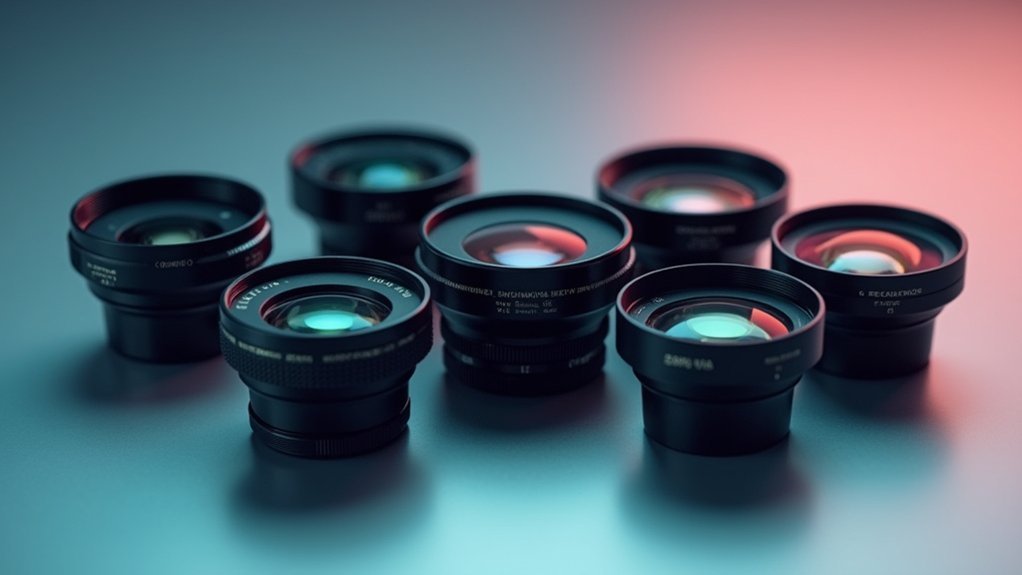
While traditional photography often struggles with limited depth of field, focus stacking has revolutionized scientific imaging by overcoming this constraint. This technique allows you to capture multiple images at different focus points and merge them into one remarkably detailed photograph.
In macro photography, where depth of field may be merely millimeters, focus stacking becomes essential for documenting specimens with exceptional image quality. You’ll need to take a series of slightly overlapping focused shots, typically using a macro focusing rail for precise adjustments.
The magic happens in post-processing, where specialized software like Helicon Focus or Adobe Photoshop aligns and blends these images. The result? A single photograph with tack-sharp focus throughout your entire subject—perfect for scientific analysis in fields like entomology, biology, and materials science.
Top Microscope Objectives for Multi-Layer Photography
When selecting microscope objectives for multi-layer photography, your choice greatly impacts the final image quality and scientific value of your work. For routine tasks, consider starting with standard 4x, 10x, 40x, and 100x objectives, adjusting based on your specimen size and detail requirements.
Plan-achromat objectives deliver superior performance with their flat field imaging and reduced chromatic aberration—essential qualities for precise image stacking.
Watch the working distance carefully; higher magnifications offer less room between the lens and specimen.
For maximum magnification and resolution, oil immersion objectives with high numerical aperture (NA) values of 1.25-1.4 provide unmatched clarity by eliminating light refraction issues.
Remember to maintain consistent lighting when stacking images from multiple objectives to guarantee your composite results show accurate colors and seamless shifts between layers.
Comparing Apochromatic vs. Achromatic Lenses for Stacking Applications

When building a lens stack for scientific photography, you’ll notice apochromatic lenses deliver superior color accuracy and sharper details than their achromatic counterparts, though at a considerably higher price point.
The investment in APO technology pays off in specialized applications like insect photography or botanical documentation, where precise color reproduction and edge definition are essential for accurate analysis.
Your choice between these lens types should align with your specific imaging requirements, balancing the enhanced optical quality of apochromatic designs against the more affordable achromatic options that may suffice for less demanding projects.
Optical Quality Differences
Although both lens types serve scientific photography purposes, apochromatic and achromatic lenses differ dramatically in their optical performance when used in stacking applications.
When you’re capturing critical scientific images, apochromatic lenses deliver superior optical clarity by focusing three wavelengths at the same point, virtually eliminating the color fringing that plagues achromatic lenses.
In macro photography, these differences become even more pronounced. You’ll notice apochromatic options produce images with better contrast and more accurate color representation—essential when documenting specimens for entomology or histology.
Their complex design incorporates higher quality glass elements that maintain sharpness even at extreme magnifications.
While you’ll pay more for apochromatic lenses, their ability to minimize distortion and maximize detail makes them the preferred choice for serious scientific imaging work requiring precision and color fidelity.
Cost-Benefit Analysis
Deciding between apochromatic and achromatic lenses for scientific photography requires careful consideration of your long-term research needs against immediate budget constraints. When conducting a cost-benefit analysis, you’ll need to weigh image quality against investment.
| Factor | Apochromatic Lenses | Achromatic Lenses |
|---|---|---|
| Initial Cost | High ($1000+) | Moderate ($200-500) |
| Image Quality | Superior, minimal fringing | Good, some color aberration |
| Precision Work | Ideal for publication-quality | Sufficient for routine work |
| Long-term Value | Better results, fewer upgrades | May require replacement |
While apochromatic lenses represent a significant upfront investment, they deliver superior results for critical scientific applications where precise color reproduction matters. Achromatic options provide a reasonable entry point for budget-conscious researchers, though you’ll likely face limitations in high-magnification stacking scenarios where color accuracy becomes essential.
Technical Application Scenarios
Researchers who stack lenses for scientific imaging face distinct performance differences between apochromatic and achromatic options across various applications.
When working with biological specimens, APO lenses deliver superior color accuracy and sharper details even at high magnifications, vital for documenting cellular structures.
You’ll find that stacking APO macro lenses maintains focus integrity across the entire field, whereas achromatic stacks often exhibit noticeable color fringing toward the edges. This difference becomes critical when photographing materials with complex textures or fine details.
The working distance also varies considerably between these options. APO stacks generally provide more comfortable working distance while maintaining image quality, allowing you to photograph delicate specimens without disturbing them.
For applications requiring precise measurement from images, the reduced chromatic aberration of APO stacks guarantees dimensional accuracy unachievable with standard achromatic configurations.
Essential Features of High-Resolution Stacking Lenses
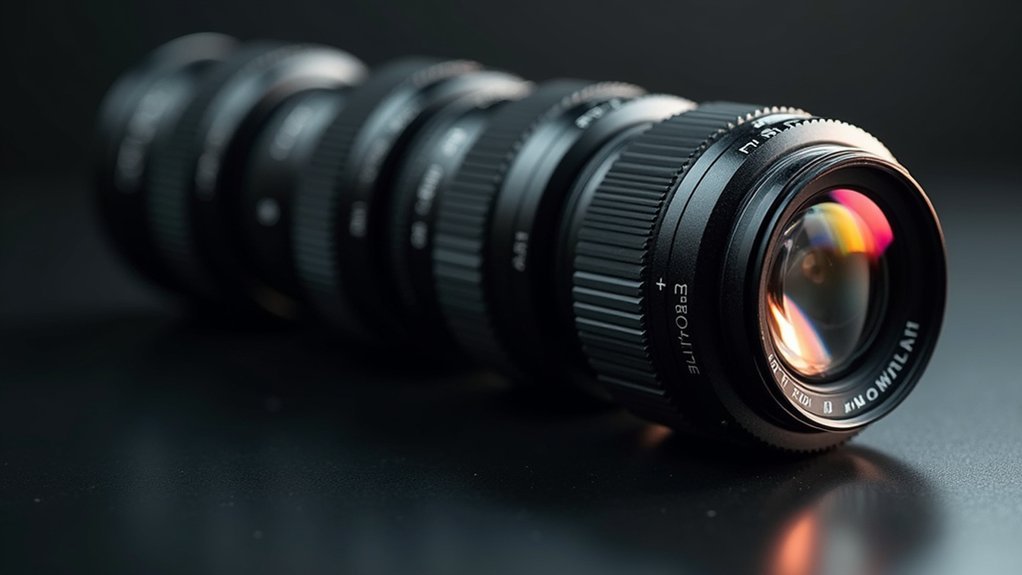
When selecting high-resolution stacking lenses for scientific photography, you’ll need to prioritize maximum resolving power with multi-element designs that capture life-size representations at 1:1 magnification or higher.
Your lens should feature advanced optical coatings that effectively control chromatic aberration and minimize distortion, essential for accurate specimen documentation.
Consider working distance options carefully, as longer focal lengths will provide the necessary flexibility to photograph sensitive subjects without disturbing them while maintaining compatibility with macro focusing rails for precise adjustments.
Maximum Resolving Power
Three critical factors determine the maximum resolving power of high-resolution stacking lenses: numerical aperture, optical quality, and effective lens combinations. When you’re capturing microscopic subjects, you’ll need lenses with high NA values (>0.8) to achieve superior light-gathering capability and exceptional sharpness.
| Factor | Impact | Optimization |
|---|---|---|
| Numerical Aperture | Determines detail resolution | Select lenses with NA >0.8 |
| Optical Quality | Minimizes aberrations | Choose lenses with specialized coatings |
| Lens Combinations | Increases magnification | Pair macro with reversed standard lenses |
Chromatic Aberration Control
Four key elements define effective chromatic aberration control in high-resolution stacking lenses.
First, premium lenses featuring low-dispersion glass elements minimize color fringing across the spectrum, ensuring your macro shots maintain accurate color representation.
Second, advanced optical coatings reduce flare and ghosting, which would otherwise exacerbate chromatic aberration in detailed scientific photography.
Third, when stacking multiple lenses, select those with similar optical characteristics to prevent compounding aberration issues. This consistency is vital for maintaining clarity in your composite images.
Finally, check manufacturer-provided MTF charts to assess a lens’s ability to maintain sharpness and color fidelity across various apertures.
While post-processing software can address residual chromatic aberration, starting with high-quality lenses greatly reduces the need for digital corrections.
Working Distance Options
Selecting the ideal working distance represents one of the most vital decisions you’ll make when configuring high-resolution stacking lenses for scientific photography. Lenses with longer focal lengths provide greater working distance between your camera and subject, reducing the risk of disturbing sensitive specimens during imaging.
When evaluating options, look for a macro lens with minimum focus distance under 30cm, allowing versatile composition while maintaining detail capture. This balance is significant for scientific work where you’ll often switch between different magnification levels.
Longer focal lengths not only provide physical clearance but also improve lighting options around your subject. Consider that while shorter working distances may offer higher magnification, they’ll limit your ability to properly illuminate specimens and might interfere with natural behaviors of living subjects you’re documenting.
Optimal Working Distances for Laboratory Specimen Photography
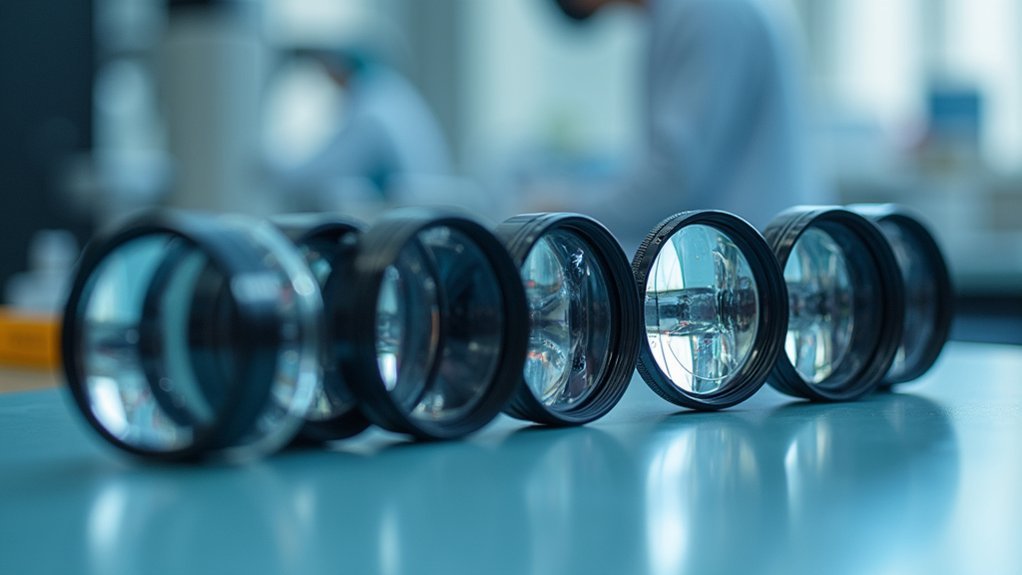
While capturing detailed images of laboratory specimens, working distance emerges as a vital factor that can make or break your scientific photography. For live specimens especially, you’ll want to maintain adequate distance to avoid disturbing your subject while still achieving the necessary magnification.
Macro lenses with focal lengths of 100mm or greater provide excellent working distances, allowing you to position your camera effectively without stressing the specimen. Though a 100mm macro lens typically offers a minimum working distance of 30-40mm, this space is essential for detailed imaging without interference.
If you’re using lens stacking techniques, such as reversing a 50mm on a 70-300mm lens, be aware that your working distance will decrease considerably.
Remember that at high magnifications, your depth of field shrinks dramatically—often to mere millimeters—requiring precise focus.
Software-Lens Integration for Advanced Microscopy Imaging
Although high-quality lenses are essential for scientific photography, they’re only half the equation when pursuing advanced microscopy imaging. Your dedicated macro lens must work harmoniously with specialized software to achieve superior results.
Focus stacking software like Helicon Focus and Adobe Photoshop allows you to combine multiple images at different focal points, dramatically enhancing depth of field in your final image. For best results, capture in RAW format to preserve maximum data for post-processing.
| Software | Best Lens Pairing | Primary Benefit |
|---|---|---|
| Helicon Focus | Nikon Macro | Real-time adjustments |
| Adobe Photoshop | Canon Macro | Superior blending |
| ZereneStacker | Olympus Micro | Enhanced clarity |
| CombineZP | Laowa Macro | Precision alignment |
This integration enables real-time analysis and adjustment, considerably improving research capabilities across biology and materials science applications.
Budget-Friendly Lens Options for Research Photography
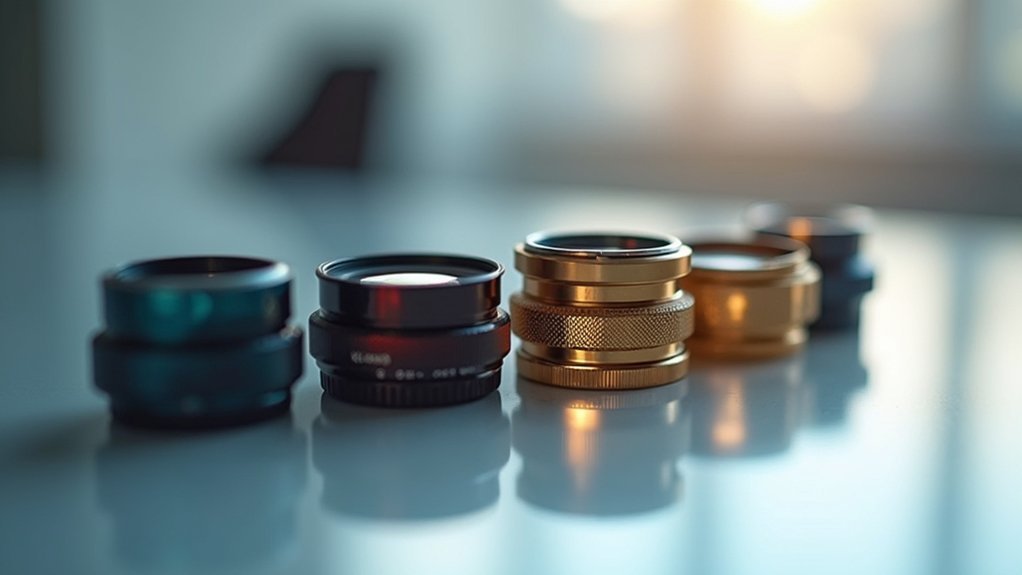
Scientific photography doesn’t always require expensive equipment to produce valuable research images. With thoughtful selection and a few accessories, you can achieve professional-quality results on a limited budget.
- Consider the Raynox DCR-250 clip-on lens to transform your existing telephoto lens into a macro powerhouse—it’s an excellent budget-friendly option that delivers impressive magnification without breaking the bank.
- The Laowa 60mm f/2.8 2:1 Ultra Macro lens offers exceptional value with its ability to achieve twice life-size magnification, making it ideal for detailed scientific photography of tiny specimens.
- Don’t overlook accessories like macro focusing rails, which dramatically improve precision with any lens setup and help maximize the potential of even the most affordable macro lens options in your research photography workflow.
Specialized Macro Lenses for Biological and Material Science Documentation
Four distinct categories of specialized macro lenses have revolutionized biological and material science documentation. True macro lenses like the Canon RF 100mm f/2.8L and Nikon Z MC 105mm offer 1:1 magnification ratios, essential for capturing intricate specimen details.
Modern macro lenses transform scientific imaging with 1:1 magnification capabilities that reveal specimen details invisible to the naked eye.
For extreme close-ups, ultra-high magnification options such as the Laowa 25mm f/2.8 deliver up to 5x magnification while maintaining critical sharpness.
Longer focal length macro lenses, including the Sigma 105mm f/2.8 DG DN, provide greater working distance—ideal when photographing live specimens without disturbance.
Meanwhile, premium options like the Tamron 90mm feature specialized coatings that reduce chromatic aberration and enhance contrast for accurate color reproduction.
When paired with focus stacking techniques, these lenses enable you to combine multiple images at different focal points, creating fully detailed results that meet scientific documentation standards.
Frequently Asked Questions
What Is the Formula for Stacking Lenses?
When stacking lenses, you’ll use the formula 1/EFL = 1/f1 + 1/f2, where EFL is the effective focal length and f1, f2 are the individual lens focal lengths. Magnification multiplies: M = m1 × m2.
Can You Stack Camera Lenses?
Yes, you can stack camera lenses. You’ll mount one lens in reverse on another using adapter rings. It’s an affordable way to achieve extreme macro magnification without specialized equipment. Working distance will be limited.
Is Focus Stacking Worth It?
Focus stacking is definitely worth it when you need extremely detailed images. You’ll capture sharpness throughout your subject that’s impossible with single shots, especially for close-up work where depth of field is limited.
What Is the Difference Between 1 1 and 1 2 Macro Lenses?
A 1:1 macro lens reproduces subjects at life-size on your sensor, while a 1:2 lens captures at half the actual size. You’ll get more detail with 1:1 lenses, but they typically require closer focusing distances.
In Summary
You’ll need to select lenses that match your specific scientific imaging requirements. Whether you’re choosing microscope objectives or macro lenses, prioritize optical quality, working distance, and compatibility with your stacking software. Don’t overlook budget options that can deliver excellent results. Remember, the best stacking lens combines resolution, clarity, and practical usability for your particular research specimens and documentation needs.


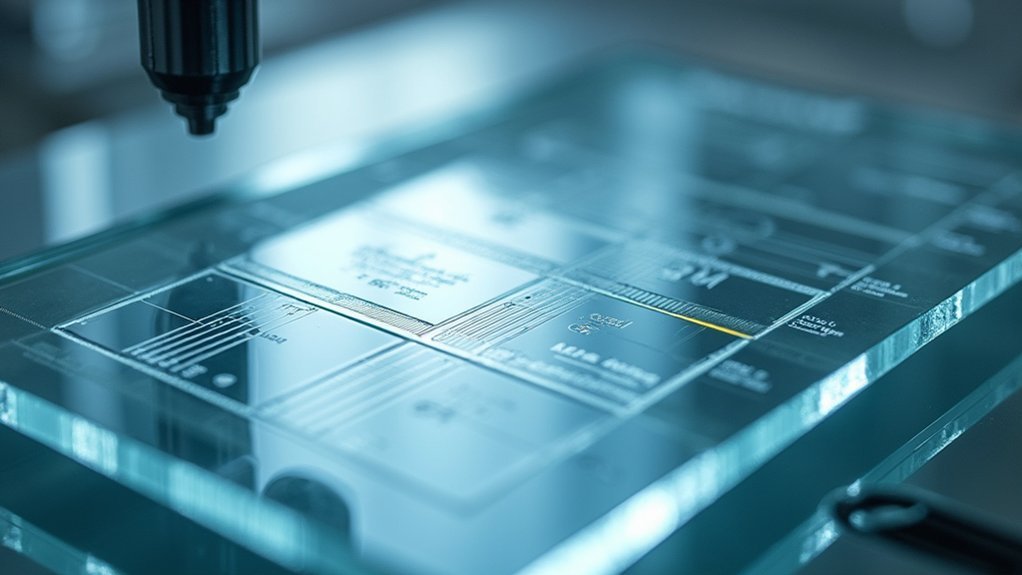
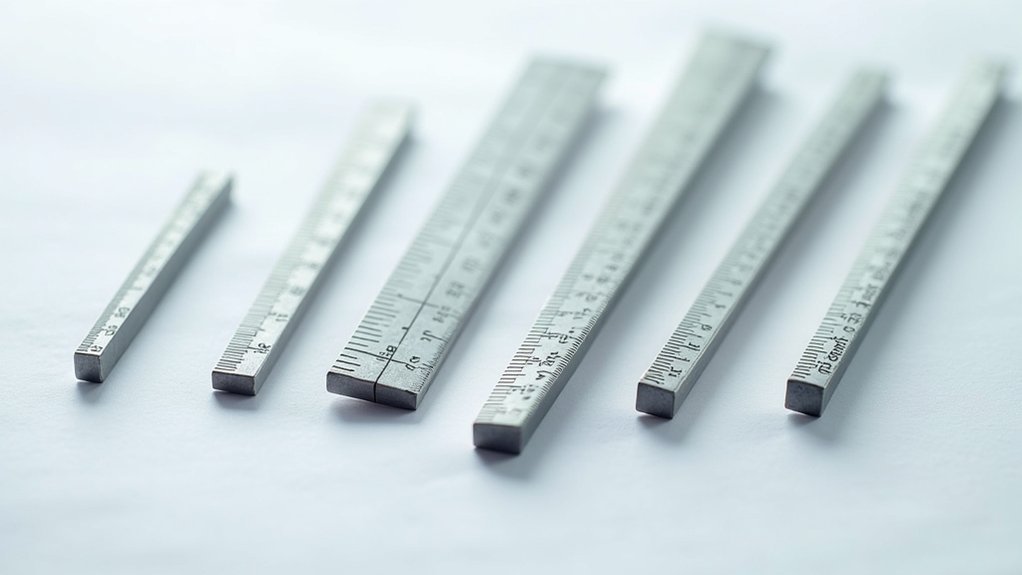

Leave a Reply